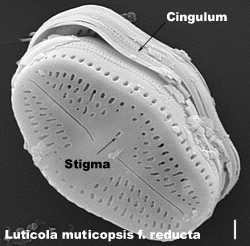| Apical axis | The long axis of a diatom |
| Arcuate | Curved like a bow, arc-shaped, bent along the apical axis |
| Attenuated | Made thin or slender in girth or transverse thickness; tapered off (see Stauroneis anceps) |
| Biarcuate | Curved on both ends |
| Capitate | Having a distinct head; knob-like or swollen at the end |
| Cingulum | A transverse groove that encircles the cell, made up of the girdle bands of a diatom |
| Cosmopolitan | Widely diffused over the globe, found in many locations |
| Distal raphe end | The external terminus of the raphe at the poles or ends of valves |
| Eccentric | Having an axis or point of support that is not centrally placed |
| Endemic | Native or limited to a certain area |
| Fascia | An unornamented area across the middle portion of a valve in pennate diatoms, generally rectangular and band-shaped |
| Fibulae | Internal struts that provide structural support to the raised keel that contains the raphe; extend transapically from the valve face to the valve mantle (Nitschia) or under the raphe in the central reigon (Denticula) |
| Frustule | The siliceous covering of a diatom cell, consisting of two valves, an epivalve (top) and hypovalve (bottom) and their associated cingulum elements |
| Gibbous | Convex, rounded, protuberant; exceeding a semi-circle but less than a circle |
| Girdle bands | The connecting structure between the mantles of the valves in a frustule |
| Keel | A raised or elevated ridge that contains the raphe, formed from a folding of the valve wall |
| Lanceolate | A shape that is wider in the center than at the ends. (see L. muticopsis f. reducta) |
| LM -Light microscopy | Using a microscope in which a beam of light passes through optical lenses to view an image of the specimen. |
| Pennate diatom | A bilaterally symmetric diatom that produces amoeboid gametes |
| Proximal raphe end | The internal terminus of the raphe near the center of valves |
| Pseudoraphe | A false raphe; an unornamented region in the axial area on the hypovalve of monoraphid pennate diatoms |
| Puncta | Pore or perforation through the valve, an areolae is a puncta bounded by an internal or external sieve membrane |
| Raphe | A slit through the valve face of monoraphid and diraphid diatoms, usually situated along the apical axis. This is the structure which enables a diatom cell to move over substrates |
| Rostrate | Terminating in a rostrum, which is a blunt tapered end to the valve resembling a beak |
| SEM - Scanning Electron Microscopy | Using a microscope in which a finely focused beam of electrons is scanned across a specimen, and the electron intensity variations are used to construct an image of the specimen. This type of microscope is ideal for magnifications from 200 to 35,000. |
| Stauros | Where the central nodule (more heavily silicified) is expanded to the valve mantle to form a crosslike structure |
| Stigma | Each of the respiratory openings or breathing-pores; a spiracle |
| Striae | Linear rows of puncta/areolae, usually oriented along transapical axis |
| Transapical axis | The axis perpendicular to the apical axis |
| Undulate | Furnished with wave-like markings |
| Valve | Siliceous part of the frustule containing most of the morphological features used to describe diatoms (taxonmically, morphologically, etc.). Each valve has two surfaces, the face and the mantle |



Resources used to help construct this glossary:
- California Academy of Sciences (CAS) Diatom Collection Glossary
- Freshwater Algae of North America, Ecology and Classification. Edited by John D. Wehr and Robert G. Sheath. Academic Press of Elsevier Science, San Diego, CA, 2003.

